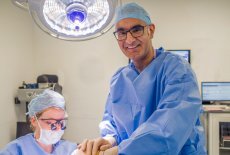Long Term Care - Breast Implants (Augmentation)
Long Term Care Following your Breast Implants
Now that you have fully settled after your breast augmentation procedure you will no longer need routine appointments. Here are a few things to keep in mind for the future:
Keep a record of your implants in a safe place. If you ever need further surgery or you need to discuss any changes in your breasts this information will be useful.
You do not need to do anything special in regard to the implants. They should last a very long time and they do not need to be routinely changed.
It is useful to regularly massage your breasts to help with the return of sensation. It can take up to 18 months after surgery for all the sensation to return though some areas of the breast may remain numb long term.
As a routine you should examine your breasts every month to look for lumps or changes. This is something all women should do whether they have implants or not. Try to do this at the same point of your menstrual cycle if possible.
Make sure you tell your doctor or other healthcare staff should you need an ultrasound scan or mammogram (or any other type of scan) on your breasts, that you have implants. Often the implants mean that an extra view needs to be taken.
Your breasts will change over time as they would do even if you didn't have implants. The breasts are more likely to droop after pregnancy or weight loss. If this is significant then a breast lift may be able to improve the shape. If you notice this or any other changes (such as change in shape or change in texture) Mr Dheansa would be more than happy to see you again to assess you and give appropriate advice.
Late Seroma and BIALCL
Recent research and clinical cases have highlighted a condition that occurs in approximately 1:30000 patients who have had breast implants. Breast Implant associated Anapaestic Large Cell Lymphoma is a cancer of the lymphatic system (part of the immune system) which is associated with the capsule (fibrous tissue) that forms around a breast implant. Patients who develop this often notice a seroma developing more than a year after their surgery.
If this should occur or if the breast becomes very swollen or changes significantly in shape then it is important to be reviewed and if necessary be further investigated.
An ultrasound scan, CT scan or MRI scan may be required and if fluid is present it may need to be drained for special testing. Patients who have developed BIALCL have been successfully treated by removing the breast implant and its capsule on both sides. Some patients have needed further treatment. Early intervention is thought to be key to effective treatment.
If you have any concerns please don't hesitate to contact Mr Dheansa or the team at the hospital where you had surgery.



